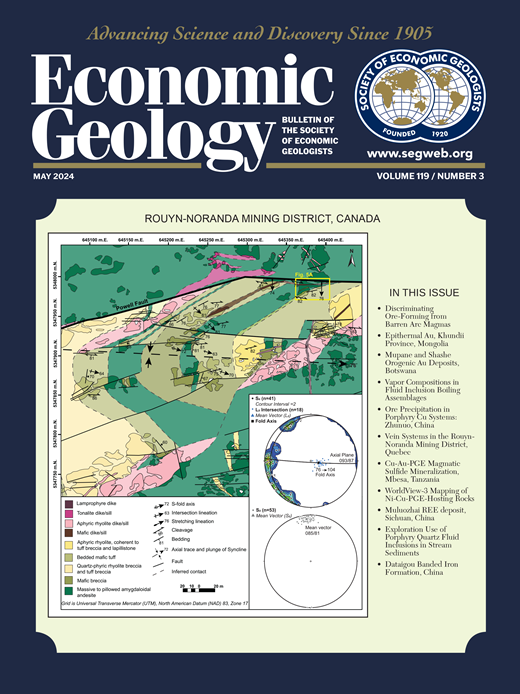佛罗里达峡谷非硫化锌矿(秘鲁北部)成因:对bongar地区表生成矿事件的新认识
IF 5.5
1区 地球科学
Q1 GEOCHEMISTRY & GEOPHYSICS
引用次数: 3
摘要
位于秘鲁北部bongar本文章由计算机程序翻译,如有差异,请以英文原文为准。
Genesis of the Florida Canyon Nonsulfide Zn Ores (Northern Peru): New Insights Into the Supergene Mineralizing Events of the Bongará District
The Florida Canyon Zn deposit in the Bongará Province of northern Peru consists of sulfide and nonsulfide mineralizations within dolomitized strata of the Triassic Chambará Formation, a member of the Triassic-Jurassic Pucará Group. The nonsulfide mineralization, which represents one third of the total resource, formed by supergene alteration of Mississippi Valley-type sulfide bodies. The nonsulfide assemblages occur in stratabound or fault-related, discordant zones that mimic the shapes of the former sulfide zones. Two nonsulfide facies can be distinguished: facies 1 – red zinc ores, which are characterized by smithsonite, or hemimorphite-dominant bodies that formed by direct replacement of primary sulfide assemblages, and facies 2 – white zinc ores, which are characterized by masses of colloform smithsonite formed by replacement of wall rock. The facies are distinct in bulk chemical composition and stable isotope geochemistry. Facies 1 shows high concentrations of Zn, Pb, Fe, Ge, Mn, and As, whereas facies 2 shows only high Zn and Cd concentrations. Enrichments in Ge, which have been reported in other Zn deposits of the Bongará Province, are associated with hemimorphite, Fe hydroxides, and remnant sphalerite in facies 1. The δ13C and δ18O signatures of smithsonite in both facies suggest that meteoric waters infiltrating the precursor sulfide bodies were affected by kinetic fractionation and originated from multiple sources at different altitude.
求助全文
通过发布文献求助,成功后即可免费获取论文全文。
去求助
来源期刊

Economic Geology
地学-地球化学与地球物理
CiteScore
10.00
自引率
6.90%
发文量
120
审稿时长
6 months
期刊介绍:
The journal, now published semi-quarterly, was first published in 1905 by the Economic Geology Publishing Company (PUBCO), a not-for-profit company established for the purpose of publishing a periodical devoted to economic geology. On the founding of SEG in 1920, a cooperative arrangement between PUBCO and SEG made the journal the official organ of the Society, and PUBCO agreed to carry the Society''s name on the front cover under the heading "Bulletin of the Society of Economic Geologists". PUBCO and SEG continued to operate as cooperating but separate entities until 2001, when the Board of Directors of PUBCO and the Council of SEG, by unanimous consent, approved a formal agreement of merger. The former activities of the PUBCO Board of Directors are now carried out by a Publications Board, a new self-governing unit within SEG.
 求助内容:
求助内容: 应助结果提醒方式:
应助结果提醒方式:


